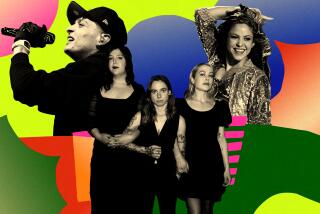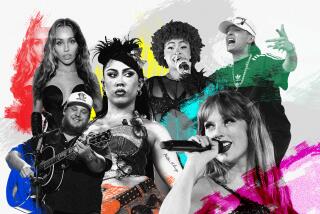Forget Knocks -- Opportunity Rings Loudly from Cellphones
- Share via
Sixteen-year-old Whitney Abraham answers only to the heartthrob hit “She Will Be Loved” by Maroon 5. For her pal Priscilla Espinoza, it’s a chirping version of “Stan” by Eminem. Their high school classmate Josh Hoffman prefers “American Idiot” by the punk band Green Day -- but that may change if you call him next week. “I’ve been cutting back,” he says, “but I still buy, like, seven a month.”
The Napster generation, whose downloading habits have battered the music industry, has finally found tunes they are willing to pay for -- in the form of customized 20- to 30-second ring tones for their cellular phones. “I’d say more than half the kids have them,” said Abraham, a student at Frazier Mountain High School in Lebec, near Gorman.
“It’s funny: Kids will illegally download a song instead of paying 99 cents for it, but they’ll pay $2.99 for a 20-second snippet off a Casio keyboard,” said Don Passman, a music industry attorney whose clients have included R.E.M. and Janet Jackson. Noting that the next edition of his popular industry primer, “All You Need to Know About the Music Business,” will need to be revised to include the phenomenon, he added: “It has exploded.”
He’s right. This year the global revenue for ring tones will exceed $3 billion, while the U.S. market in 2004 more than doubled to $315 million and is expected by many industry estimates to spike an additional 20% to 30% by the 2005 holiday season. That’s a tune catching the ear of the music world.
Madonna this year became the first major artist to set up a ring tone “shop” on the Internet. Ludacris, a star rapper whose beats have been favorites for fans’ phones, recorded a performance this week to be used exclusively by InfoSpace Mobile to produce ring tones. And when Universal Music Group released Eminem’s “Encore” last month, it included in the package a free ring tone offer to fans who bought the album -- a bid to offset piracy but also an acknowledgment of the ring tone’s value as pop culture currency.
Even the trade magazine Billboard, which for more than a century has defined what is and isn’t a hit, has just added a ring tone chart to its pages. And on Wednesday, when industry players gather in Las Vegas for the Billboard Music Awards, a new category will premiere: ring tone of the year. The nominees are bleating, blooping versions of rap hits -- “Hey Ya!” by OutKast, “Dirt off Your Shoulder” by Jay-Z and two hits by 50 Cent, “In Da Club” and “P.I.M.P.” -- a nod to young America’s passion for the genre as well as the music’s tidy translation to simplified rhythms.
All of this is music to the ears of telecommunication carriers, ring tone merchants and songwriters -- the groups profiting most from the ring tone boom. Western Europe and Asia account for the lion’s share of the industry’s revenue, according to Consect, an analysis firm that tracks the business. In London, ring tones are so wildly popular that you can buy them from vending machines in some Underground stations. The downside of such popularity was apparent in Copenhagen, where the conductor leading the Danish Symphony Orchestra recently halted a performance of Ravel when a cellphone offered a rival melody.
In Japan, the average cellphone subscriber purchases 17 ring tones a year, according to telecommunications surveys there. That ubiquity is a long way off in America, but the tinny tunes are already an entrenched part of campus life here.
“I defy you to go into any high school classroom anywhere and not find at least one ring tone,” said Zena Burns, music editor of Teen People. “It’s all about personalization and expression, and a ring tone tells everyone around you something about you.” Burns says her magazine is mulling promotional uses of ring tones, and that fits in with plenty of other corporate plans. “The thing with ring tones is if you find a way to have the one everyone wants, you’ll need a garbage truck for the money.”
Still, novelties tend to have brief shelf lives, and it’s not clear how long consumers will continue paying $1 to $3 for a snippet of a song, especially with the advent of software such as Xingtone, which helps ring tone devotees get their snippets free if they are willing to spend a bit of time and effort to do so.
Boosters, however, see a fast-growing market, an endless appetite for personalized items among young consumers and an unyielding desire to be the “first kid on the block” with the latest ring tone. The technological advances in wireless phones that have made the boom possible are continuing; upcoming generations of phones promise increased capacity that will allow even more bells and whistles.
The process now most often goes like this: A cellphone user with a relatively new phone can add a ring tone by pushing the “download” option on the phone’s menu. (There’s also the other option of browsing through ring tones online.) That will display the choices -- such as “Drop It Like It’s Hot,” the Snoop Dogg hit that is the No. 1 ring tone of the moment. But because the tone is an instrumental version -- sort of a funky version of Muzak -- the transaction generates money for the hit’s songwriters and its music publisher but not the record label, in this case Geffen Records, part of the Universal Music Group.
So while the record labels are the segment of the music industry that has claimed to be most injured by illegal file-sharing, they have yet to cash in on ring tones in a major way. That may change, though, in the months to come as so-called master tones become a widely available option for the next generation of cellphones.
Ring tones have already evolved from the primitive monophonic tunes of a few years ago -- think Fisher-Price toy keyboard -- to the more layered and nuanced polyphonic tones, which sound like the synthesizer jam in some early 1980s pop tune. Already many new cellphones allow ring tones carved out of actual hit songs; with a master tone, a fan of U2’s new hit “Vertigo,” for instance, would get the band’s version and Bono’s voice calling out “Hello, hello, hola....” With master tones, the labels would have a place at the ring tone table.
For now, the ring tone beneficiaries in music circles tend to be people such as Martin Bandier, chairman and chief executive of EMI Music Publishing, the world’s largest music publishing company. The company licenses its storehouse of music properties -- including “Over the Rainbow,” “Santa Claus Is Coming to Town,” “Sweet Home Alabama” and “My Boo” -- for use in films, television, video games, toys and other forums. It was three years ago at a Manhattan brasserie when Bandier learned that opportunity not only knocks, it rings.
“I heard this strange sound, this tune -- ba-doomp, ba-doomp.... It was Henry Mancini’s ‘The Pink Panther.’ It was coming from a woman’s cellphone.” It sounded like digital crickets to some diners, but to Bandier it rang out like a cash register. “I scheduled a meeting the next morning with my staff and we got into the business,” said Bandier, whose company began policing the ring tone use of its songs -- including “The Pink Panther” theme -- and setting license rates for the music’s use. The first six months of this year the rings generated $12 million for EMI.
“It’s just starting here,” Bandier said of the U.S. market, “but it’s coming on like a storm.”
The last storm in the music industry was piracy via file sharing, and the ring tone is not immune to similar digital pickpocketing. But the wireless networks are “walled gardens” compared with the vast untamed Internet; anonymity runs counter to the basic transaction’s need for a phone number as delivery destination. Also, the carriers are very effective as tollkeepers, so this market trend has been an orderly push.
Bandier and others said master tones could expand the market dramatically to include, for example, classical music fans who’d rather hear the lush stylings of Yo-Yo Ma as a ring than something that sounds like an arcade game.
Another nascent offering is “ring backs,” ring tones that are bought and sent by the caller as a kind of Digital Age equivalent to the singing telegram. Some say the novelty of surprising someone with “Happy Birthday” or “I Just Called to Say I Love You” could make the ring back the 21st century greeting card.
“Music is a lifestyle, and people now have the ability to put a soundtrack to their lives. And maybe ring tones will be a big part of that -- a fun part and a growing part,” Bandier said. After a pause, his voice dropped a few notes: “It’s all happened so fast, though, that you worry it will go just as fast as it came. I don’t think it will. But it’s something that you worry about in the back of your mind.”
* (BEGIN TEXT OF INFOBOX)
Name that tune Billboard recently launched a ÒHot RingtonesÓ chart of the top 20 polyphonic ring tone sales each week. Here is the Dec. 4 list:
1. ÒDrop It Like ItÕs HotÓ (Snoop Dogg featuring Pharrell) 2. ÒMy BooÓ (Usher and Alicia Keyes) 3. ÒLose My BreathÓ (DestinyÕs Child) 4. ÒLean BackÓ (Terror Squad) 5. ÒBalla BabyÓ (Chingy) 6. Ò1, 2 StepÓ (Ciara featuring Missy Elliott) 7. ÒShorty Wanna RideÓ (Young Buck) 8. ÒLetÕs GoÓ (Trick Daddy featuring Lil Jon and Twista) 9. ÒLocked UpÓ (Akon featuring Styles P.) 10. ÒGoodiesÓ (Ciara featuring Petey Pablo) 11. ÒYeah!Ó (Usher featuring Lil Jon and Ludacris) 12. ÒYouÕre a Mean One Mr. GrinchÓ (Boris Karloff) 13. ÒFreek-A-LeekÓ (Petey Pablo) 14. ÒSpongeBob SquarePants ThemeÓ (The Pirates) 15. ÒBig PimpinÕ Ó (Jay-Z featuring UGK) 16. ÒAmerican IdiotÓ (Green Day) 17. ÒThe Pink Panther ThemeÓ (Henry Mancini) 18. ÒSuper Mario Brothers ThemeÓ (Koji Kondo) 19 ÒJingle BellsÓ (Perry Como) 20. ÒBad BoysÓ (InnerCircle)
Source: Billboard
More to Read
The biggest entertainment stories
Get our big stories about Hollywood, film, television, music, arts, culture and more right in your inbox as soon as they publish.
You may occasionally receive promotional content from the Los Angeles Times.










